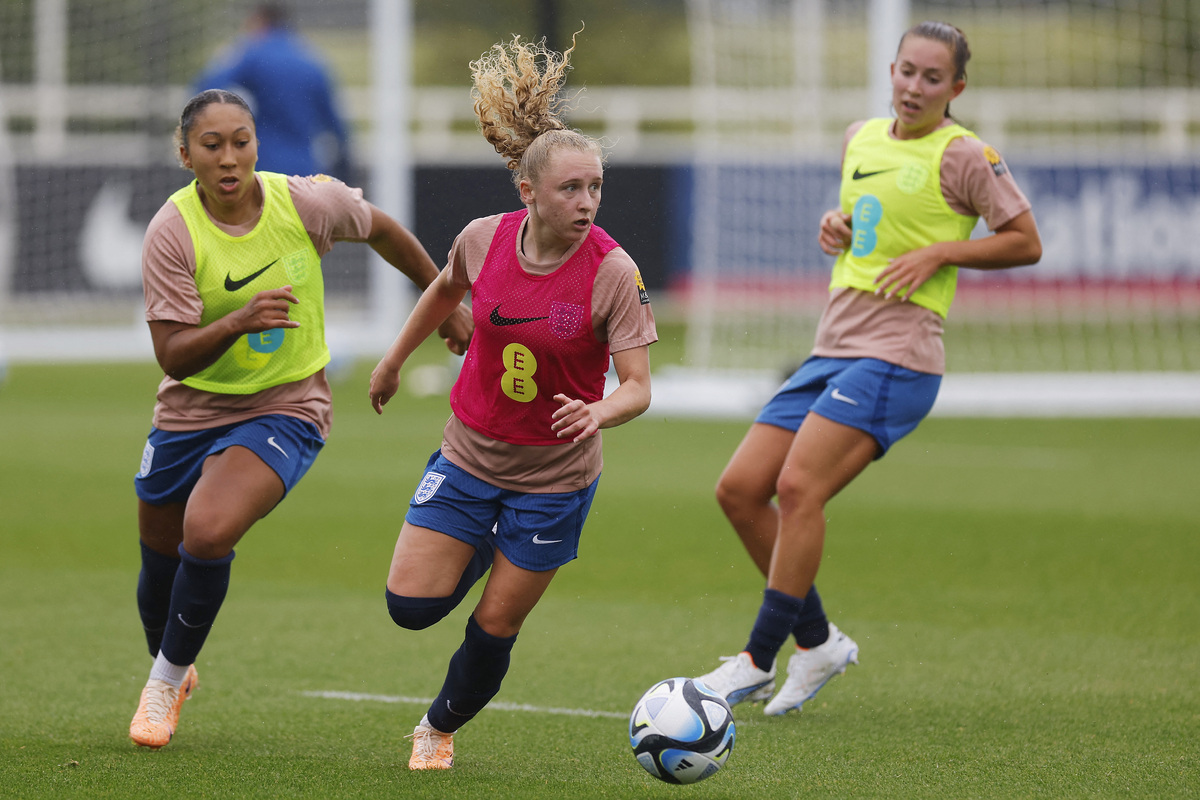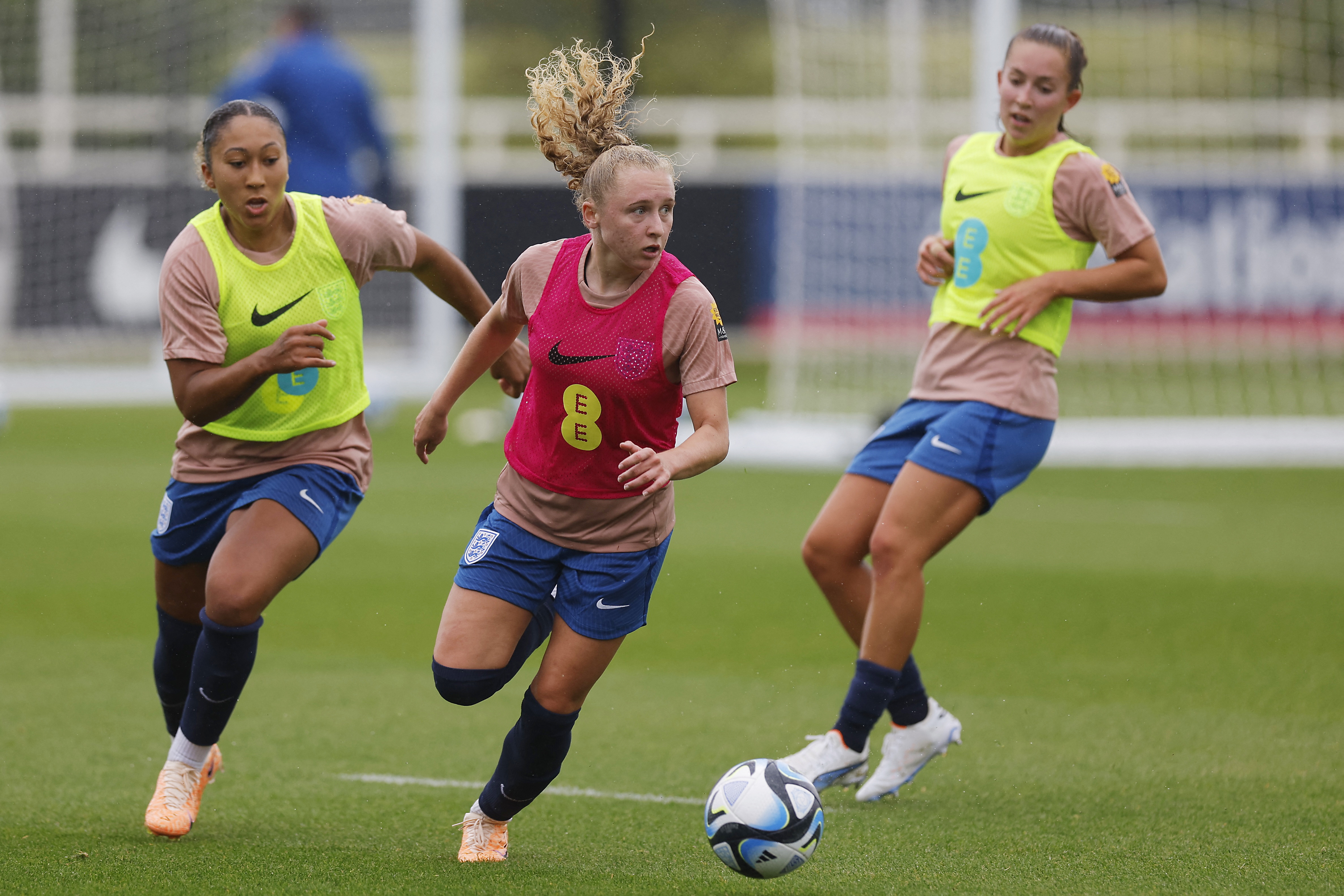You are viewing 1 of your 1 free articles
Oral Contraceptives Chronicles
Candice MacMillan provides athletes, coaches, and sports medicine practitioners with important information about oral contraceptives.
England’s Katie Robinson with teammates during training Action Images via Reuters/Andrew Couldridge
Injury rates in gender-comparable sports are higher among female athletes participating at different levels of play(1). In addition to anatomical and biomechanical differences, sex hormone (estrogen/estradiol, progesterone, and relaxin) profiles contribute to this sex disparity in musculoskeletal (MSK) injuries(2,3). Continuous hormonal fluctuations throughout the menstrual cycle (MC) affect the material structure and mechanical properties of muscle, tendon, bone, and ligaments(2,4-6). The influence of hormonal contraception (HC) on athletic injury risk and performance is a contentious topic, and research findings are conflicting(3,7).
In a recent investigation of 430 elite female athletes, almost 50% of athletes used HC, indicating that half of the surveyed population did not have eumenorrheic (normal) MCs(8). Most (68%) of these athletes reported taking oral contraceptive pills (OCPs), making them the most commonly used hormonal contraceptives(9). Aside from birth control, athletes strategically use OCPs to alleviate symptoms associated with dysmenorrhea, menorrhagia, and premenstrual syndrome and to manipulate the timing of inconvenient withdrawal bleed(7,9).
Understanding Oral Contraceptives
Oral contraceptives (OC) are exogenous hormones that inhibit ovulation and result in consistently low endogenous sex hormone concentrations. The various OCPs have different compositions and potencies (see table 1)(8,9).
The type and concentration of estrogen and progestin vary and may influence athletes’ physiological responses(3,9). Monophasic oral contraceptives are the most common form of hormonal contraceptive and typically consist of 21 pill consumption days, followed by 7-day pill-free intervals, repeated continuously(10). They significantly downregulate endogenous estrogen and progesterone concentrations compared with the menstrual cycle’s mid-luteal phase (see figure 1)(7,9,11).
Related Files

The endogenous hormonal profile of an OCP user is comparable to the profile observed during the early follicular phase of the physiological menstrual cycle, i.e., correspondingly low levels of endogenous estrogen and progesterone.
“Oral contraceptives are exogenous hormones that inhibit ovulation and result in consistently low endogenous sex hormone concentrations.”
Injury risk influence
The fluctuation of reproductive hormones throughout the MC is a risk factor for acute and overuse injuries(2,5,6). Relaxin and estrogen promote catabolic processes in MSK tissue, increasing ligament laxity and injury risk, while progesterone decreases ACL laxity and relaxin-induced collagen degradation(2,3). As oral contraceptives drastically lower relaxin and estrogen levels and elevate progesterone levels, several studies propose that using them may be protective against injury(2,13). Researchers at Stanford University Medical Center in the USA conducted a systematic review investigating their effect on soft tissue injury risk and tissue laxity, highlighting the inconsistency in findings(3). For example, two high-quality and four low-quality studies concluded that oral contraceptives decrease and do not affect ACL injury risk(7). One very low-quality study determined that they increase the risk of developing Achilles tendinopathy(3). Practitioners must consider studies’ methodological quality when looking at research for practice guidelines. They should interpret the results from low-quality studies with caution.
Furthermore, the researchers described similar findings and methodological quality inconsistencies regarding the effect of oral contraceptives and soft-tissue laxity(3). The general conclusion was that they might reduce ACL injury rates and anterior tibial translation(3). While studies have examined the effects of HC on MSK function, fewer have set out to determine the specific impact of different formulations on ligaments, tendons, and muscles(3).
“Researchers have argued for and against this debate, and it remains unclear whether hormonal contraceptives are protective, detrimental, or noninfluential for MSK injury risk.”
Biochemical markers of bone metabolism are used to evaluate bone responses to therapeutic agents, diet, exercise, and, in turn, fracture risk(10). British researchers found that bone resorption markers are significantly affected by using oral contraceptives, although bone formation markers do not vary substantially(10). Among American collegiate female athletes, stress fractures which most commonly occurred in the foot, did not appear to be associated with the type of hormones contained in OCPs(6). However, injectable hormonal contraception and past menstrual irregularity were associated with an increased stress fracture risk(6).
Similar to soft-tissue injuries, a causal relationship between oral contraception use and bone injuries remains debatable. Oral contraceptives can, however, mask menstrual dysfunction or irregularity, as athletes can misinterpret the withdrawal bleed as a menstrual cycle. Early detection of the female athlete triad, of which menstrual irregularity and low bone mass density are characteristics, could be affected(6,10).
Influence of oral contraception on performance
Studies evaluating the effect of oral contraceptive use on athletes’ strength have yielded conflicting results and are low quality(3). It is, therefore, impossible to make definitive conclusions regarding the effects of oral contraceptives on muscle strength(3). Among highly trained Canadian female athletes, decreased maximal aerobic capacity was associated with using a triphasic oral contraceptive(14). However, there were no significant changes in performance measures (anaerobic speed test, aerobic endurance, isokinetic strength).
British researchers conducted a systematic review to investigate the effect of oral contraceptives on female athletes’ exercise performance. They found that, on average, they might result in slightly inferior performance compared to naturally menstruating female athletes(7).
Exercise guidelines for female athletes who use oral contraceptives are not necessary; an individual athlete approach might be more beneficial.
Additionally, athletes’ performance was not affected between pill-taking and pill-free days, indicating that female athletes do not need to consider the contraceptive cycle for performance. From a practical perspective, these results suggest that practitioners don’t need to make particular exercise guidelines for female athletes using oral contraceptives(7). It might be more beneficial to take an individual athlete approach, focusing on each athlete’s response, as some athletes may be affected, and some may not be.
Conclusion
Exogenous hormones inhibit the endogenous production of estrogen, and progesterone decreases significantly. As a result, they eliminate the hormonal changes found throughout the normal menstrual cycle(3,8). Considering the effects of natural hormonal fluctuations on injury risk, several studies propose that oral contraceptives may be protective against injury(15). Using them in combination with or without neuromuscular training may increase the dynamic stability of the knee joint and decrease ACL injury risk in female athletes(3,15). Research investigating the effect on other soft tissue injuries is less prevalent, and the methodological quality is low. On the other hand, because contraceptives control menstruation, it can mask menstrual irregularity and its related adverse effects(6).
“From a practical perspective, these results suggest that practitioners don’t need to make particular exercise guidelines for female athletes using oral contraceptives.”
Researchers have argued for and against this debate, and it remains unclear whether hormonal contraceptive are protective, detrimental, or noninfluential for MSK injury risk. Similarly, studies have found that they might result in slightly inferior exercise performance on average compared to naturally menstruating women. However, an individualized athlete approach might be more appropriate when exercise performance is a priority.
References
- Br J Sports Med. 2017;51(6):487-488
- BMJ Open Sport Exerc Med. 2021;7(4):e001170
- Orthop J Sports Med. 2019;7(3):232596711983106
- J Sports Sci. 2019;37(15):1787-1793
- Br Med Bull. 2016;117(1):39-58
- PM&R. 2021;13(11):1207-1215
- Sports Med. 2020;50(10):1785-1812
- Contraception. 2013;88(3):408-412
- Int J Sports Physiol Perform. 2018;13(7):926-932
- Bone. 2021;145:115864
- Sports Med. 2022;52(7):1453-1456
- OBG Manag. 2020 December;32(12):24, 27-31
- Muscle Ligaments Tendons J. 2019;07(01):136
- Br J Sports Med. 2003;37(4):315-320
- Strategies for intervention. Sports Med Auckl NZ. 2000;29(5):313-327
Further reading
Newsletter Sign Up
Subscriber Testimonials
Dr. Alexandra Fandetti-Robin, Back & Body Chiropractic
Elspeth Cowell MSCh DpodM SRCh HCPC reg
William Hunter, Nuffield Health
Newsletter Sign Up
Coaches Testimonials
Dr. Alexandra Fandetti-Robin, Back & Body Chiropractic
Elspeth Cowell MSCh DpodM SRCh HCPC reg
William Hunter, Nuffield Health
Be at the leading edge of sports injury management
Our international team of qualified experts (see above) spend hours poring over scores of technical journals and medical papers that even the most interested professionals don't have time to read.
For 17 years, we've helped hard-working physiotherapists and sports professionals like you, overwhelmed by the vast amount of new research, bring science to their treatment. Sports Injury Bulletin is the ideal resource for practitioners too busy to cull through all the monthly journals to find meaningful and applicable studies.
*includes 3 coaching manuals
Get Inspired
All the latest techniques and approaches
Sports Injury Bulletin brings together a worldwide panel of experts – including physiotherapists, doctors, researchers and sports scientists. Together we deliver everything you need to help your clients avoid – or recover as quickly as possible from – injuries.
We strip away the scientific jargon and deliver you easy-to-follow training exercises, nutrition tips, psychological strategies and recovery programmes and exercises in plain English.













